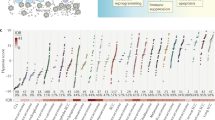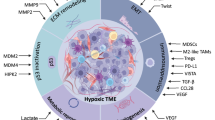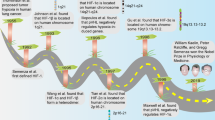Abstract
Deregulated tumour growth and neovascularization result in an inadequate tumour blood supply, leading to areas of chronic hypoxia and necrosis. Irregular vascular structure and abnormal tumour physiology also cause erratic blood flow in tumour vessels. We reasoned that tumour stroma, including vascular endothelial cells, would consequently experience transient hypoxia that may allow transcriptional targeting as part of an antivascular gene therapy approach to cancer. To exploit hypoxia for transcriptional regulation, retroviral vectors were generated with modified LTRs: a 6-mer of hypoxia response elements in place of the viral enhancer produced near wild-type levels of expression in hypoxia but was functionally inert in normoxia. In a tumour xenograft model, expression was mainly around areas of necrosis, which were shown to be hypoxic; no expression was detected in tumour stroma. Time-course experiments in vitro demonstrated that expression was transient in response to a hypoxic episode, such that a reporter gene would be insensitive to acute hypoxia in vivo. In contrast, a significant therapeutic effect was seen upon ganciclovir administration with a vector expressing thymidine kinase (TK) in the tumour stroma. Expression of TK was more effective when targeted to acute hypoxia in the stroma compared to chronic hypoxia in the poorly vascularized regions of the tumour cell compartment. The data presented here are evidence that hypoxia in the stromal compartment does occur and that transient hypoxia constitutes a valid therapeutic target.
This is a preview of subscription content, access via your institution
Access options
Subscribe to this journal
Receive 12 print issues and online access
$259.00 per year
only $21.58 per issue
Buy this article
- Purchase on Springer Link
- Instant access to full article PDF
Prices may be subject to local taxes which are calculated during checkout






Similar content being viewed by others
References
Vaupel P, Thews O, Hoeckel M . Treatment resistance of solid tumors: role of hypoxia and anemia. Med Oncol 2001; 18: 243–259.
Skinner SA, Frydman GM, O'Brien PE . Microvascular structure of benign and malignant tumors of the colon in humans. Dig Dis Sci 1995; 40: 373–384.
Grunt TW, Lametschwandtner A, Karrer K, Staindl O . The angioarchitecture of the Lewis lung carcinoma in laboratory mice (a light microscopic and scanning electron microscopic study). Scan Electron Microsc 1986 (pt 2): 557–573.
Trotter MJ, Chaplin DJ, Durand RE, Olive PL . The use of fluorescent probes to identify regions of transient perfusion in murine tumors. Int J Radiat Oncol Biol Phys 1989; 16: 931–934.
Kimura H et al. Fluctuations in red cell flux in tumor microvessels can lead to transient hypoxia and reoxygenation in tumor parenchyma. Cancer Res 1996; 56: 5522–5528.
Helmlinger G, Yuan F, Dellian M, Jain RK . Interstitial pH and pO2 gradients in solid tumors in vivo: high-resolution measurements reveal a lack of correlation. Nat Med 1997; 3: 177–182.
Gray LH et al. The concentration of oxygen dissolved in tissues at the time of irradiation as a factor in radiotherapy. Br J Radiol 1953; 26: 638–648.
Durand RE, Aquino-Parsons C . Non-constant tumour blood flow – implications for therapy. Acta Oncol 2001; 40: 862–869.
Epstein AC et al. C. elegans EGL-9 and mammalian homologs define a family of dioxygenases that regulate HIF by prolyl hydroxylation. Cell 2001; 107: 43–54.
Bruick RK, McKnight SL . A conserved family of prolyl-4-hydroxylases that modify HIF. Science 2001; 294: 1337–1340.
Berra E et al. HIF prolyl-hydroxylase 2 is the key oxygen sensor setting low steady-state levels of HIF-1alpha in normoxia. EMBO J 2003; 22: 4082–4090.
Ivan M et al. HIFalpha targeted for VHL-mediated destruction by proline hydroxylation: implications for O2 sensing. Science 2001; 292: 464–468.
Jaakkola P et al. Targeting of HIF-alpha to the von Hippel–Lindau ubiquitylation complex by O2-regulated prolyl hydroxylation. Science 2001; 292: 468–472.
Masson N et al. Independent function of two destruction domains in hypoxia-inducible factor-alpha chains activated by prolyl hydroxylation. EMBO J 2001; 20: 5197–5206.
Jeong JW et al. Regulation and destabilization of HIF-1alpha by ARD1-mediated acetylation. Cell 2002; 111: 709–720.
Lando D et al. Asparagine hydroxylation of the HIF transactivation domain a hypoxic switch. Science 2002; 295: 858–861.
Mavria G, Porter CD . Reduced growth in response to ganciclovir treatment of subcutaneous xenografts expressing HSV-tk in the vascular compartment. Gene Therapy 2001; 8: 913–920.
Mavria G, Harrington KJ, Marshall CJ, Porter CD . In vivo efficacy of HSV-TK transcriptionally targeted to the tumour vasculature is augmented by combination with cytotoxic chemotherapy. J Gene Med 2004; published online 15 Nov 2004, doi:10.1002/jgm.662.
Richardson TB, Kaspers J, Porter CD . Retroviral hybrid LTR vector strategy: functional analysis of LTR elements and generation of endothelial cell specificity. Gene Therapy 2004; 11: 775–783.
Mavria G, Jager U, Porter CD . Generation of a high titre retroviral vector for endothelial cell-specific gene expression in vivo. Gene Therapy 2000; 7: 368–376.
Jain RK . The Eugene M. Landis Award Lecture 1996. Delivery of molecular and cellular medicine to solid tumors. Microcirculation 1997; 4: 1–23.
Boast K et al. Characterization of physiologically regulated vectors for the treatment of ischemic disease. Hum Gene Ther 1999; 10: 2197–2208.
Yuan Y, Hilliard G, Ferguson T, Millhorn DE . Cobalt inhibits the interaction between hypoxia-inducible factor-alpha and von Hippel–Lindau protein by direct binding to hypoxia-inducible factor-alpha. J Biol Chem 2003; 278: 15911–15916.
Black ME, Kokoris MS, Sabo P . Herpes simplex virus-1 thymidine kinase mutants created by semi-random sequence mutagenesis improve prodrug-mediated tumor cell killing. Cancer Res 2001; 61: 3022–3026.
Prentice H et al. Regulated expression of a foreign gene targeted to the ischaemic myocardium. Cardiovasc Res 1997; 35: 567–574.
Patterson AV et al. Oxygen-sensitive enzyme-prodrug gene therapy for the eradication of radiation-resistant solid tumours. Gene Therapy 2002; 9: 946–954.
Brizel DM et al. Tumor hypoxia adversely affects the prognosis of carcinoma of the head and neck. Int J Radiat Oncol Biol Phys 1997; 38: 285–289.
Fyles AW et al. Oxygenation predicts radiation response and survival in patients with cervix cancer. Radiother Oncol 1998; 48: 149–156.
Zagzag D et al. Expression of hypoxia-inducible factor 1alpha in brain tumors: association with angiogenesis, invasion, and progression. Cancer 2000; 88: 2606–2618.
Graeber TG et al. Hypoxia-mediated selection of cells with diminished apoptotic potential in solid tumours. Nature 1996; 379: 88–91.
Hockel M et al. Association between tumor hypoxia and malignant progression in advanced cancer of the uterine cervix. Cancer Res 1996; 56: 4509–4515.
Cosset FL et al. High-titer packaging cells producing recombinant retroviruses resistant to human serum. J Virol 1995; 69: 7430–7436.
O'Hare MJ et al. Conditional immortalization of freshly isolated human mammary fibroblasts and endothelial cells. Proc Natl Acad Sci USA 2001; 98: 646–651.
Porter C . Retroviral vectors for suicide gene therapy. Methods Mol Med 2004; 90: 91–106.
Acknowledgements
We thank Demelza Bird for her assistance with the in vivo work and the Breast Cancer Pathology Core Unit for the processing, embedding and sectioning of the tumours. The TK SR39 cDNA is proprietary to Celltech R&D Inc.; we are grateful to Margaret Black and Celltech for the provision of this material. We are grateful to Mike O'Hare and the Ludwig Institute for Cancer Research for providing the immortalized fibroblast and endothelial cell cultures, HMFD and HMME7, and to the Centers for Disease Control and Prevention, Atlanta for the HMEC-1 cell line. This work was funded by the Institute of Cancer Research.
Author information
Authors and Affiliations
Rights and permissions
About this article
Cite this article
Ingram, N., Porter, C. Transcriptional targeting of acute hypoxia in the tumour stroma is a novel and viable strategy for cancer gene therapy. Gene Ther 12, 1058–1069 (2005). https://doi.org/10.1038/sj.gt.3302504
Received:
Accepted:
Published:
Issue Date:
DOI: https://doi.org/10.1038/sj.gt.3302504
Keywords
This article is cited by
-
Adenovirus-mediated hypoxia-targeted gene therapy using HSV thymidine kinase and bacterial nitroreductase prodrug-activating genes in vitro and in vivo
Cancer Gene Therapy (2011)
-
Role of cell surface molecules and autologous ascitic fluid in determining efficiency of adenoviral transduction of ovarian cancer cells
Cancer Gene Therapy (2010)
-
Complement insufficiency limits efficacy in a xenograft model of hyperacute rejection for cancer therapy
Cancer Immunology, Immunotherapy (2007)



